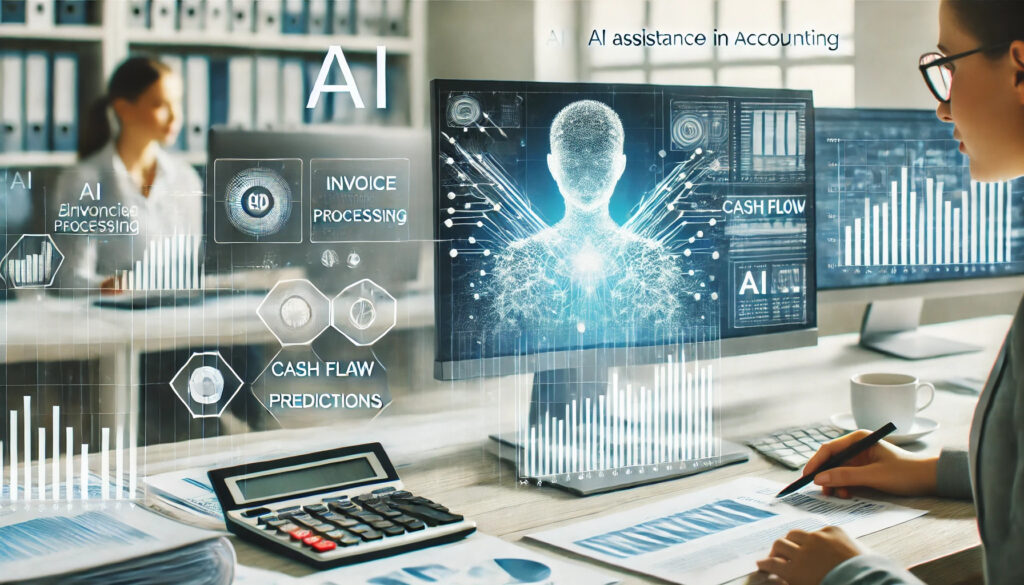
Historically, the field of accounting has relied significantly on human computations, record-keeping, and adherence to constantly changing rules. However, many of these jobs may now be automated thanks to the development of artificial intelligence (AI), which reduces human error, saves time, and makes it possible to report financial data more accurately.
AI in accounting goes beyond simply taking the place of accountants. Rather, it is an effective instrument that enhances their work and makes accounting procedures more strategic and effective. This article will examine how artificial intelligence (AI) can be used to tackle accounting-related problems and provide answers to prevalent issues facing the sector. We’ll also look at some of the most popular AI tools that are influencing accounting’s future.
Key Problems in Traditional Accounting vs AI in Accounting
Before diving into the solutions provided by AI, it’s important to understand some of the common challenges accountants face in a traditional setting:
1. Inconsistent Financial Reporting
The discrepancy that can occur in financial reporting is one of the main problems with traditional accounting. When several accountants handle different bookkeeping tasks or interpret data in different ways, the outcomes can frequently be incorrect, which causes disparities in reports. Confusion, a misunderstanding of financial health, and even problems with compliance may result from this discrepancy.
AI Solution: AI tools can standardize financial reporting by applying consistent rules and frameworks to data, ensuring reports are uniform, accurate, and compliant with industry standards. They can automate report generation, reducing the risk of human errors in the final output.
2. Lack of Real-Time Insights
Financial data is frequently processed in batches in traditional accounting systems, and accountants produce reports every month or every three months. Businesses may not have access to real-time insights that are essential for making decisions and spotting financial problems early on as a result of this delay in updating financial data.
AI Solution: AI-powered accounting platforms enable real-time data processing, giving businesses up-to-the-minute insights into cash flow, profit margins, and other financial metrics. These systems can generate reports and provide dashboards that update continuously, helping businesses make proactive decisions based on current data.
3. Difficulty in Handling Complex Tax Calculations
Tax rules are intricate and can change greatly between jurisdictions or geographical areas. Accurately calculating taxes in traditional accounting can be challenging, particularly for businesses with worldwide or multi-state activities. Businesses could also find it difficult to keep up with new or evolving tax regulations.
AI Solution: AI tools can automate tax calculations and ensure they comply with the most recent tax codes. By continuously monitoring tax law changes, AI can adjust tax calculations in real-time, reducing the risk of errors and the need for manual intervention. Some AI systems can even prepare tax filings automatically.
4. Inability to Scale with Growing Business Demands
As businesses grow, so does the volume and complexity of their financial transactions. Traditional accounting systems may struggle to keep up with increasing transaction volumes, resulting in inefficiency, slower processes, and the potential for errors as the workload becomes too heavy for the human team to manage.
AI Solution: AI tools can scale with the business, processing large volumes of data quickly and efficiently. Whether it’s handling thousands of transactions or generating complex financial reports, AI-powered accounting systems can handle growth without the need for additional resources or personnel.
How AI Accounting Challenges Solvers Address
AI is well-suited to solve many of these problems. Here are the key areas where AI has made a significant impact:
- Automating Data Entry and Cutting Down on Mistakes Data extraction from bank statements, invoices, and receipts can be automated with AI-powered solutions, especially those that use optical character recognition (OCR) and machine learning (ML). These technologies precisely capture and enter data into accounting systems, lowering the possibility of human error.
- Integration of OCR and AI: AI systems are able to scan documents and identify important information such as invoice numbers, dates, amounts, and payees. After that, they directly enter this data into accounting software.
- Machine Learning for Data Validation: AI programs are able to learn from past entries and automatically identify inconsistencies and mistakes as they arise.
- Reconciliation Driven by AI
Account reconciliation is one of the accounting processes that takes the longest. By automatically matching transactions from various sources, artificial intelligence (AI) solutions can expedite this process, saving time on manual checks while increasing accuracy. - Automated Matching: AI systems are able to automatically match financial documents such as invoices, receipts, and payments. They compare these records to bank statements, looking for differences and emphasizing things that need to be addressed.
- Updates in Real Time: AI-powered reconciliation solutions offer real-time data, guaranteeing that any discrepancies are detected right away and facilitating a speedier settlement.
- In-depth Financial Evaluation
By spotting patterns, making predictions, and pointing out areas where costs might be cut, artificial intelligence (AI) applications can help with financial data analysis. Large datasets can have patterns that machine learning systems might identify that human accountants might not see right away. - Predictive analytics: AI systems can forecast future cash flows, revenue, and possible financial hazards by evaluating historical financial data. This allows for more precise planning and budgeting.
- Data Visualization: AI technologies frequently have strong visualization features that transform complicated financial data into dashboards that are simple to comprehend. Both corporate leaders and accountants can use these visualizations to make well-informed judgements.
- Keeping Up with Regulations
- It can be very difficult to stay on top of regulatory developments. By keeping track of modifications to tax legislation, financial reporting specifications, and international accounting standards, artificial intelligence (AI) technologies can assist in monitoring compliance.
- Regulatory Monitoring: To make sure that companies remain in compliance, AI technologies can continuously search legal databases for modifications to tax laws, accounting standards, and other regulations.
- Automated Reporting: Businesses can ensure timely submission of correct and compliant financial documentation by using a variety of AI-powered accounting systems that can automatically generate reports that adhere to the most recent regulatory standards.
Top AI Tools for Accounting

Several AI-powered tools have already been adopted widely in the accounting industry to solve the challenges mentioned above. Here’s a list of some of the most popular and effective tools:
1. QuickBooks Online (with AI features)
One of the most popular platforms for accounting software is QuickBooks Online. It automates processes like expense classification and report recommendation using machine learning. Features driven by AI assist companies in effectively managing accounting procedures and maximizing cash flow.
Features include transaction matching, automatic classification, and predictive insights.
Benefits of AI include a decrease in manual data entry and data-driven insights that assist firms in optimizing their financial plan.
2. Xero (AI and Automation)
Another well-known accounting application that combines automation and AI is Xero. Users can easily manage receipts, automate invoicing, and reconcile bank transactions with Xero’s AI-powered capabilities.
Features include automated invoicing, expense claims, and real-time reconciliation.
Benefit of AI: It allows accountants to handle high transaction volumes with little manual involvement.
3. Botkeeper
A program called Botkeeper uses artificial intelligence (AI) to automate bookkeeping processes like financial reporting, bank reconciliation, and invoice processing. To deliver precise findings, its AI-powered algorithms are always learning and getting better.
Features include real-time insights, AI-driven reports, and bookkeeping automation.
AI Benefit: Increases accuracy and efficiency by drastically reducing the requirement for manual bookkeeping chores.
4. Zeni (AI for Accounting & Tax)
Zeni is an AI-driven accounting program made especially for new businesses. By automating bookkeeping, tax filing, and cost management, it guarantees accurate and current financial records.
Features include tax filing, expense tracking, and automated bookkeeping.
AI Benefit: Guarantees adherence to tax laws and removes the need for manual tax computations.
5. Expensify
Expensify is an expense management app that automates cost reporting and receipt scanning with artificial intelligence. The technology can automatically create thorough reports and connect transactions with receipts.
Features include real-time reporting, automated matching, and receipt scanning.
AI Benefit: Saves time and effort by automating the entire process, making expenditure reporting smooth.
6. Sage Intacct
AI and machine learning are integrated into Sage Intacct, a cloud-based financial management software, to help automate accounting procedures, increase accuracy, and simplify financial reporting.
Features include real-time financial dashboards, automatic accounts payable and receivable, and multi-dimensional reporting.
AI Benefit: Optimizes reporting with machine learning, guaranteeing that data is accurate and meaningful. Additionally, it reduces the need for manual involvement by automating typical financial processes.
7. Tally.ai
An intelligent accounting solution called Tally.ai was created to help companies automate their financial management and bookkeeping processes. It makes use of AI to produce accurate financial reporting, increase efficiency, and lower errors.
Features include bank reconciliation, AI-driven reporting, and automatic transaction classification.
AI Benefit: Tally.ai makes accounting easier and faster by utilizing machine learning and natural language processing (NLP) to assist businesses in managing their finances.
8. Wave Accounting
For small businesses, Wave Accounting is a free cloud-based accounting program that uses artificial intelligence (AI) to automate bookkeeping, invoicing, and payment processing.
Features include accounting reports, receipt scanning, cost monitoring, and invoicing.
AI Benefit: Wave’s AI solutions produce real-time financial reporting and automate the classification of expenses. By providing automated recommendations for transaction categorization, it can also assist companies in minimizing human mistake.
9. BlackLine
Blackline is a financial automation program made to help larger businesses handle their accounting processes. In order to ensure accurate and compliant financial reporting, it incorporates AI to automate the accounting, financial closing, and reconciliation procedures.
Features include compliance monitoring, financial closure management, and automated reconciliation.
Benefit of AI: By automating the reconciliation process and offering sophisticated tools for ensuring adherence to financial rules, Blackline’s AI improves financial controls.

Conclusion
Numerous issues that have historically beset the accounting sector have been resolved by the revolutionary use of AI in the field. AI provides observable advantages that boost productivity, lower errors, and guarantee compliance, from automating repetitive processes like data entry and reconciliation to facilitating more complex financial analysis and fraud detection.
We may anticipate even more cutting-edge solutions as AI develops, which will further simplify accounting procedures and free up accountants to concentrate on more valuable, strategic work. The accounting sector will surely change as a result of the use of AI tools, becoming more data-driven, accurate, and flexible.
